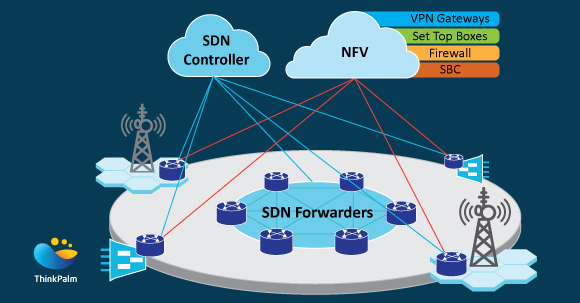You may not get astounded by the title “Software Defined Future” because most of you already live in the software defined world. But while coming to the world of IT network infrastructure backbones that drive this software, it is still driven by the good old complex distributed hardware systems. If you have been exploring how to improve your IT network, you would have come across the buzzwords SDN, NFV, Cloud etc. This blog talks about the vast transition that is happening now in the networking world from hardware enabled IT systems to the era of software enabled Centralized Virtual Network Functions (VNFs) in enterprises.
Software Defined Networking (SDN) – SDN allows you to manage your hardware networking elements (NEs) using centralized software but it doesn’t virtualize any networking components. It is essentially a next generation network management solution that is intended to dynamically create and manage programmable networks. It is all about centralizing the network intelligence, whether it is software or hardware.
Network Functions Virtualization (NFV) – NFV is all about the virtualization of hardware network components. It completely decouples the network resources from the underlying hardware. This helps a network administrator to move a virtual network component like router to another logical domain without actually having to wire up new physical connections.
Software Defined Networking
Centralized network management provides end-to-end visibility of data flow and thereby provides an opportunity to optimize the routing by monitoring the load on various network paths. SDN separates the networking functions into two plains or groups, Control Plain and Data Plain which were tightly coupled in legacy networking devices. Control plain is considered to be the decision maker and the data plain is responsible for forwarding of data. Now the control plain is taken out of the distributed networking devices such as switches or routers to a centralized server or a PC whereas data plain remains on the distributed network switches which do not have any complex intelligence.
In traditional IP networks, routers in the network perform two tasks, Forwarding and Routing.
- Forwarding
- Observing the packet header
- Consulting the Forwarding Information Base (FIB)
- Forwarding the packet
- Routing
- Communicating with neighboring routers to discover topology (Routing protocols)
- Run routing algorithms and get the shortest path
- Populating FIB used in packet forwarding
In SDN architecture, routing algorithms will run from centralized server (SDN controller) and forwarding will be done through simple dump SDN switches instead of traditional complex routers.
Network Functions Virtualization
Today’s IT infrastructure consists of various network elements (NEs) such as Ethernet Switches, IP Routers, Fibre transceivers, DSL modems, VOIP gateways, NATS, Firewalls, performance monitoring probes, WAN accelerators, DPIs etc. More complex NEs are being invented all the time; equipment vendors prefer the complexity since it is a business opportunity but service providers find it difficult to incorporate the same into their existing infrastructure, both in commercial terms and the difficulty in management. All these devices are vendor proprietary making service providers too dependent on their vendors for further services or updates. All these, together with the overall increase in OPEX and CAPEX compared to the revenue, have made the telecom industry less attractive for future investments. Here comes the significance of Network Functions Virtualization (NFV)! It is not only the PCs which can be virtualized, but most of the network elements mentioned above as well!
Here are the potential candidates for virtualization:
Switching Elements: Ethernet Switch, IP Router, CG NAT, Broadband Network Gateway
Security Functions: Firewall, IDS/IPS, Spam protectors
Mobile Network Nodes: NodeB, eNodeB, HLR/HLS, SGSN
Residential Nodes: Home Network Routers, Set Top Boxes
Tunnelling Gateways: IPSec/SSL VPN Gateways
Traffic Analysis: DPI analysis, QoE measurement
NGN Signalling: SBCs, IMS
QoS: Service assurance, SLA monitoring
Traffic analysis: DPI, QoE Measurement
SDN and NFV are not mutually exclusive! In many cases implementing both can be useful. SDN is a highly centralized network management tool but it doesn’t reduce the dependency on the specific topology of the underlying physical hardware- a necessity for enabling agility and speed. NFV delivers that agility by moving network functions into software to eliminate hardware dependence. It allows virtual machines to move and be followed by all associated network functions anywhere the datacentre is virtualized!




